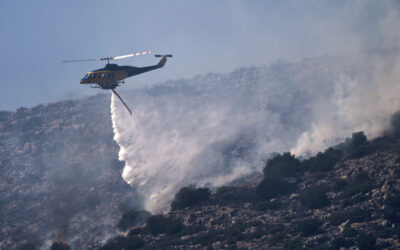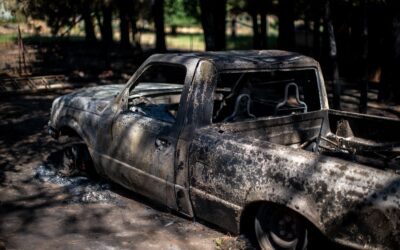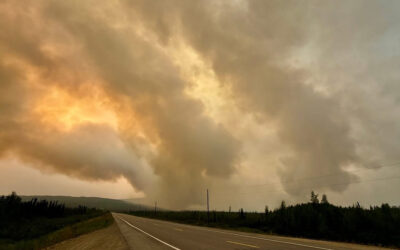May 15—Fuel for chainsaws. Food and water for Pulaski-toting firefighters doing the exhaustive work of digging fire lines. Ample first aid kits with spendy epi-pens in case a wildland firefighter steps on a hornet’s nest and suffers a life-threatening allergic reaction.
They are the kinds of things that can make or break beating back a wildfire and ensuring the safety of fire crews. And they are the kinds of things jeopardized amid the Trump Administration’s efforts to slash the government’s federal spending.
It has led to a chaotic prep season for wildfire managers as they fret about money, resources and a rapidly approaching summer. And the future isn’t looking promising.
“There’s no way someone would be taking this action if they were aware of the risk to public safety this entails,” said Rachel Granberg, a union representative for the National Federation of Federal Employees.
Granberg is an 11-year employee with the U.S. Forest Service and stationed in Wenatchee, currently working as a squad boss on a helitack crew, a person who fights fires, manages firefighters and manages aircraft.
She has avoided being fired by the Trump Administration, but many of the staff designated to support people like her on the front lines of a raging fire have not.
Since Trump and adviser Elon Musk terminated 2,000 Forest Service employees in February, the number has grown to 5,000 “non-fire” employees through early retirements, resignations and buyout offers. U.S. Sen. Patty Murray, D-Wash., estimates 7,400 Forest Service employees nationwide were cut, according to a news release from her office, and about 75% of these employees are trained to assist in fighting fire.
Around the same time, Trump also issued an executive order barring federal union employees from collective bargaining agreements after their terminations were reinstated. The process playing out in courts has been confusing and convoluted, leaving some to just leave the agency altogether with no hope of coming back.
While the government maintains those terminated are not firefighters, they are critical to how firefighters operate, Granberg said. Many of the employees let go were part of designated Incident Management Teams, or teams put together to make large-scale plans to fight wildfires.
Some of them coordinate who is in the airspace, assign aircraft to a fire, designate where a helicopter base will be or map the topography of the area. Some are mapping the fire as it spreads, and communicating with people in the field about where to go and what to do. Others are tasked with ordering a communications trailer, setting up portable bathrooms, making sure tents show up to camp on time or bringing food and water back and forth to firefighters.
And the layoffs in fuel mitigation, an attempt to control brush and trees before a fire gets out of control, could instead breed a fire that quickly spreads.
The stress surrounding fire resources isn’t strictly within the federal government. It’s bled over to state agencies, who have mutual aid agreements with the Forest Service.
“There are lots of firings at these agencies, and there’s been no communication, or very little, on any of that,” said Dave Upthegrove, the public lands commissioner for the Washington State Department of Natural Resources. “We’ve been doing our best to analyze what’s going on and adjust as needed, but the fact is, we don’t know much more.”
It’s usually possible the DNR firefighters will be battling the same fire as the Forest Service, just in different locations, because a fast-paced fire can, and will, cross jurisdictional lines.
“Let’s say there was a fire in one of the national forests. I can assure you DNR resources are going to be part of the initial attack because that forest may not have enough fire units on it to do an initial attack of an extreme fire,” said DNR spokesperson Ryan Rodruck.
The Forest Service also has the ability to order DNR resources to help fight a fire outside of DNR range. And when a fire is spreading, it’s important that order must be done quickly, Rodruck said.
“Wildfire is complicated, there are a lot of moving parts. When the feds make it unclear what the structure is for fighting fire without consulting the state partners, it gets really difficult knowing what the status of those resources are going to be,” he said. “They’ve laid off people and consolidated resources, but they’re not discussing this with the state … If we need a specialized unit like a hotshot crew, we don’t have clarity on their availability.”
Federal lands make up more than 40% of public lands in Washington, according to data from DNR, and more than 275,000 acres burned in Washington in 2024. About 194,000 of those acres were DNR land, the data shows.
“It is mission critical we have fully staffed teams when I’m out there fighting fire. We are working 16-hour days for 14 days straight. We need people to bring us chainsaw fuel and boxes of water and medical supplies,” Granberg said. “We are completely engaged in stopping the fire. Without people to bring supplies, there is going to be a serious safety risk and a work slowdown.”
At the same time, many of the crews with purchasing power for supplies on the front lines have been completely cut off from doing so.
In a March email obtained by The Spokesman-Review, a Forest Service supervisor sent out a mass message to crews indicating their purchasing cards, or government-issued cards used to buy supplies for firefighters and the tools they use, were dropped to just a $1 limit.
“There was an exemption made for emergency response, essentially fire and fire adjacent support,” the supervisor wrote in the email. “However, we know that some card holders slipped between the cracks and need to be reinstated so that incident operations can continue now and into the future.”
When Granberg heard the cards were run dry, she laughed. But then she got angry.
“You can’t even go to the dollar store with that,” she said.
In the Okanogan-Wenatchee National Forest, crews used to have 500 purchasing cards. They now only have 50, Granberg said.
For the cards that do still work, the cardholder — usually someone in a leadership role — is required to submit a request for every purchase that will go up the chain of command.
Sometimes the person just won’t hear back, Granberg said, even when every second counts during a rapid, ever-changing environment like a dangerous wildfire. And because the cardholder now must buy supplies for everyone else who no longer can, it’ll create a mountain of extra paperwork.
“It’s like a full-time job dealing with purchase paperwork when you’re supposed to be out fighting fires,” she said.
Purchasing power for fuel for chainsaws alone is a problem the entire agency is facing due to the budget restrictions, Granberg said — it’s a huge concern when a chainsaw is the first step to creating a “fuel break” or a spot where vegetation is mitigated to decrease the spread of a fire.
“Chainsaws go first. Then behind them is the dig line, they scratch everything down to soil. You can’t move the dig line if you don’t have chainsaws,” Granberg said. “Water or retardant dropped out of helicopters only buy you time — they’re not a replacement. No matter how much money you have for aircraft, if you don’t have money for chainsaw fuel, you are running a huge risk.”
Her crews are also working with expired epinephrine, an immediate solution to anaphylactic shock. The medication is more than a year old, Granberg said.
It’s too early to tell what this year’s fire season will look like, Rodruck said, but because the snow and water equivalent is low, it might affect how quickly fire fuels like brush and trees dry out. It’s also too early to tell what void DNR may have to fill under the mutual aid agreements with the federal government.
“DNR has a responsibility to respond to wildfires across all landscapes. The government has historically been a key partner in that,” Upthegrove told The Spokesman-Review. “DNR would have to fill the void. And we will fill the void. We are going to do what it takes.”
Firefighters going into fire season are already exhausted, Granberg said. The constant back and forth of being fired and reinstated coupled with the concern over retirement benefits is wearing down employees right before a season where they should be at their best.
“Watching our friends get terminated and told they have two hours to pack up and leave has a cumulative effect,” she said. “We need to come back, ready to fight, and everyone is already exhausted.”
Among Granberg’s fears about the firings is a loss of public land. If the people who manage the lands are gone and the lands fall into disrepair, it’ll be easier to justify selling them off, she said.
“I don’t think people realize the importance of our public lands. Everything that is happening will directly impact their ability to enjoy them. Public land is our nation’s greatest treasure,” she said. “My fear is that it’s going to take a bad fire season to realize the value of federal employees and what they provide.”
© 2025 The Spokesman-Review (Spokane, Wash.). Visit www.spokesman.com. Distributed by Tribune Content Agency, LLC.




